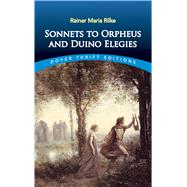Sonnets to Orpheus and Duino Elegies

Sonnets to Orpheus and Duino Elegies
- ISBN 13:
9780486838670
- ISBN 10:
0486838676
- Format: Paperback
- Copyright: 01/15/2020
- Publisher: Dover Publications
List Price $5.93 Save
| TERM | PRICE | DUE |
|---|---|---|



List Price $5.93 Save $0.28
Usually Ships in 2-3 Business Days
We Buy This Book Back!
Free Shipping On Every Order
Note: Supplemental materials are not guaranteed with Rental or Used book purchases.
Extend or Purchase Your Rental at Any Time
Need to keep your rental past your due date? At any time before your due date you can extend or purchase your rental through your account.
Summary
Although his poetry was recognized and admired by leading European artists, the Austro-Bohemian poet was virtually unknown during his lifetime, achieving international acclaim only with these final masterpieces. This edition presents translations by Jessie Lemont, praised by London's Times Literary Supplement for their presentation of Rilke as "a writer of short individual lyrics, often of incomparable, impressionist vividness, plastic vitality and symbolic suggestiveness."






